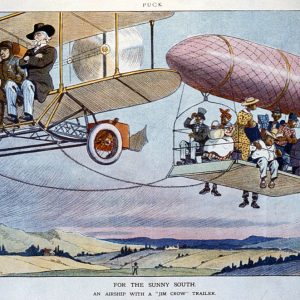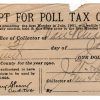calsfoundation@cals.org
Jim Crow Laws
Jim Crow laws were statutes passed in most of the Southern states between the 1880s and 1960s that separated the races and created a segregated society. Exactly why these laws were implemented at this time is unclear, although scholars believe that they may have been a response to the breakdown of traditional barriers between black and white people in the post-Reconstruction era.
This breakdown was made possible by expansion of the South’s railroads, development of urban areas and industrial workplaces, and the progress African Americans made economically during this period. Whatever the reason for the timing of their passage, these laws reflected prevalent anti-black racism and the views of contemporary whites, who asserted that African Americans represented an inferior and dangerous race that needed to be controlled and kept from mixing with whites. The very name, Jim Crow, was at the time of the enactment of these laws a racial epithet for black people, derived from an 1828 song, “Jumping Jim Crow,” sung by a black-faced minstrel. The authors of these laws intended discrimination and drew upon both religion and science to justify their basic prejudices against blacks.
Legal separation of the races was not new in the 1880s but usually was unnecessary because custom and economic opportunities often kept the races separate. As to the law, the Fourteenth and Fifteenth amendments to the U.S. Constitution and Arkansas’s own civil rights acts of 1868 and 1873 made the denial of access to public institutions on the basis of race illegal and any legal discrimination unconstitutional. Nonetheless, these restrictions provided room for interpretation and the possibility of discrimination. The 1873 Arkansas act, for example, reflected the reality that blacks and whites were treated differently in life and simply required that if an institution was segregated, each race had to be provided the same and equal services. This rationale justified the legal separation of the races in the first public school system. Still, legislators were reluctant to create legal segregation prior to the 1880s, and most public facilities, particularly the railroads and other transportation systems, provided equal access to their services.
The power of tradition in race relations meant that when legal separation did come, the laws passed did not reflect efforts at creating some sort of rational or systematic form of segregation but were responses to problems perceived at the time. In 1884, the state legislature passed an anti-miscegenation law that declared all marriages between blacks and whites to be illegal; this was not very controversial because an older 1837 anti-miscegenation law was still thought to be in effect at the time. Although state legislatures elsewhere in the South developed more statutory regulations, Arkansas’s legislators saw no need for further action until 1891. That year, the legislature passed the Separate Coach Law, requiring the separation of the races in railroad coaches. Blacks in Arkansas and elsewhere in the South protested such laws, but they were unsuccessful. Any question that such laws might be unconstitutional was resolved in 1896 when, in the case of Plessy v. Ferguson, the U.S. Supreme Court determined that state and local governments could require separation of the races in public accommodations. They offered the same rationale for such legislation provided by the Arkansas Civil Rights Act of 1873, determining separation to be legal so long as equal facilities were made available for blacks.
While Plessy v. Ferguson paved the way for further legislative efforts at segregation, the Arkansas legislature did not move forward rapidly. Instead, over the next several decades, it addressed perceived new problems as they arose. The next major Jim Crow law was not passed until 1903, when the legislature returned to pass the Streetcar Segregation Act, which required blacks and whites riding streetcars to be placed in separate sections of the car. The law continued to stay within the constitutional limits set by the Supreme Court when it required that the facilities must be equal. Separation, however, was required.
In 1921, the legislature went further than it had in its 1884 anti-miscegenation law and prohibited even the cohabitation of blacks and whites, defining a black person as any person with a single drop of African-American blood in his veins. In 1937, racetracks and gambling establishments were segregated. Some of the most far-reaching efforts at statutory segregation came at the very time that black citizens began a major assault on segregation in the 1940s. In 1947, the legislature revised the code of laws, referring back to an 1891 law that demanded segregation at polling places and a 1903 statute mandating segregation within prisons; it also reinforced a 1919 law that required mines to provide separate washrooms for the races. The legislature also stiffened penalties for public transportation that failed to provide segregated facilities.
The same legislature also went even further in controlling personal relations between blacks and whites, prohibiting not only marriage but declaring even sexual relations between the races to be illegal and providing stiff penalties for disobeying the law. A person convicted for a third time could be imprisoned for up to three years. The same law also addressed the issue of public education. Earlier laws had required that separate public schools be required for black students; the 1947 law continued to enforce an outright prohibition against integrated schools.
When compared with the Jim Crow laws passed in other states, Arkansas appears on first glance to have intervened little legislatively in race relations. In fact, the state’s legislature only became involved when customary separation of the races broke down. In everyday life, segregation touched the lives of blacks and whites to a much greater degree than the laws suggest. By the end of the Jim Crow era, even though specific laws were never passed, most stores, restaurants, and hotels were racially segregated. Social conventions even demanded the separation of such everyday facilities as water fountains for the races.
Ultimately, all such Arkansas laws were struck down in the course of the civil rights movement of the 1950s and the 1960s and the federal legislation that accompanied it. The landmark Supreme Court decision in Brown vs. Board of Education of Topeka, Kansas in 1954 struck at the very idea that separate institutions could in any way be equal and required the integration of public schools. The Civil Rights Act of 1964 brought an end to other forms of segregation, banning racial separation in all public accommodations and facilities.
For additional information:
Cell, John W. The Highest Stage of White Supremacy: The Origins of Segregation in South Africa and the American South. Cambridge: Cambridge University Press, 1982.
Donato, Rubén, and Jarrod Hanson. The Other American Dilemma: Schools, Mexicans, and the Nature of Jim Crow, 1912–1953. New York: State University of New York Press, 2021.
Elman, Cheryl, Kathryn Feltey, Barbara Wittman, Corey Stevens, and Molly B. Isenberg. “‘Little Baby’s gone to Heaven’: A Mixed-Methods Study of Black Children’s Survival Disadvantage in Jim Crow–Era Arkansas.” Social Science History, June 3, 2025. https://doi.org/10.1017/ssh.2025.15 (accessed June 6, 2025).
Giggie, John M. After Redemption: Jim Crow and The Transformation of African American Religion in the Delta, 1875–1915. New York: Oxford University Press, 2008.
Gordon, Fon Louise. Caste & Class: The Black Experience in Arkansas, 1880–1920. Athens: University of Georgia Press, 1995.
Graves, John William. “The Arkansas Separate Coach Law of 1891.” Arkansas Historical Quarterly 32 (Summer 1973): 148–165.
———. “The Arkansas Separate Coach Law of 1891.” Journal of the West 7 (October 1968): 531–541.
———. “Jim Crow in Arkansas: A Reconsideration of Urban Race Relations in the Post-Reconstruction South.” Journal of Southern History 55 (August 1989): 421–448.
———. Town and Country: Race Relations in an Urban-Rural Context, Arkansas, 1865–1905. Fayetteville: University of Arkansas Press, 1990.
Kousser, J. Morgan, ed. “A Black Protest in the ‘Era of Accommodation’: Documents.” Arkansas Historical Quarterly 34 (Summer 1975): 149–175.
Stockley, Grif. Ruled by Race: Black/White Relations in Arkansas from Slavery to the Present. Fayetteville: University of Arkansas Press, 2009.
Carl H. Moneyhon
University of Arkansas at Little Rock
 Jim Crow Laws Cartoon
Jim Crow Laws Cartoon 





Comments
No comments on this entry yet.